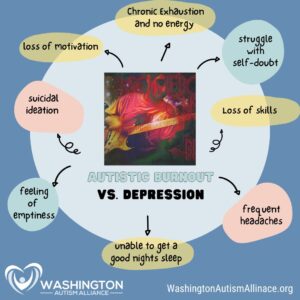When it comes to mental health, particularly within the autistic community, it’s crucial to distinguish between autistic burnout and depression. While they share some overlapping symptoms, these are distinct experiences that require different approaches to support and management. Join us on May 22nd, 12-1pm [Register Here] to learn more.
What is Autistic Burnout?
Autistic burnout is a state of physical, mental, or emotional exhaustion, often accompanied by a loss of skills, increased sensory sensitivity, and a reduced tolerance to stimuli. It’s typically the result of chronic life stress and the mismatch between expectations and abilities, especially in environments that are not adequately supportive or accommodating for neurodivergent individuals.
Key Characteristics of Autistic Burnout
- Chronic Exhaustion: This can manifest physically, mentally, emotionally, or socially, leading to a depletion of energy from overextending oneself in daily life.
- Loss of Function: Individuals experiencing burnout might find it difficult to perform tasks they previously managed, impacting their work, school, and daily living.
- Reduced Tolerance to Stimulus: Increased sensitivity to environmental stimuli, making it harder to tune things out and leading to overwhelm.
Factors Leading to Autistic Burnout
- Masking: Camouflaging autistic traits to fit in can be incredibly draining and contribute to burnout.
- External Expectations: Societal, family, school, or work expectations that do not align with an autistic person’s needs and abilities.
- Disability Management: The constant effort to navigate and manage one’s disability in a world not designed for neurodiversity.
- Life Changes and Stressors: Transitions, mental health crises, and other life stressors can accumulate and trigger burnout.
How is Autistic Burnout Distinct From Depression?
While depression and autistic burnout can share symptoms like low mood and loss of interest, they have distinct underlying causes and manifestations.
Differences in Exhaustion
- Autistic Burnout: Exhaustion is often a direct result of the demands of navigating a neurotypical world, including masking and managing sensory overload.
- Depression: Fatigue in depression is typically internal, not necessarily tied to external stressors or sensory experiences.
Differences in Recommendations
- Autistic Burnout: Rest, reduced stimulation, and time alone are often crucial for recovery.
- Depression: Behavioral activation, such as socializing and engaging in activities, is often recommended. However, what works for depression is often the opposite of what is needed for autistic fatigue.
Differences in Withdrawal
- Autistic Burnout: Withdrawal is often due to overwhelming stimuli and the need to reduce sensory input.
- Depression: Withdrawal is often due to low mood, lack of motivation, and social disengagement.
Self-Care and Support
Recovering from autistic burnout requires a holistic approach.
Key Solutions
- Acceptance and Social Support: Support from individuals who understand and accept one’s autistic identity is crucial.
- Self-Knowledge: Understanding one’s triggers, needs, and what brings comfort is essential for self-advocacy.
- Boundary Setting: Establishing and enforcing boundaries to protect one’s energy and well-being.
- Accommodations: Seeking accommodations at school or work to reduce stress and demands.
- Self-Care: Engaging in activities that are calming and restorative, such as spending time in nature or pursuing special interests.
Impacts
Autistic burnout can significantly impact health, capacity for independent living, and overall quality of life. It’s essential to recognize the signs early and take steps to address it.
Seeking Help
If you suspect you or someone you know is experiencing autistic burnout, it’s important to seek support from understanding individuals, therapists, or support groups. Finding a therapist who is familiar with autism and autistic burnout can make a significant difference.
Conclusion
Understanding the distinction between autistic burnout and depression is vital for providing appropriate support and intervention. Recognizing the unique needs and experiences of autistic individuals can help in fostering more inclusive and accommodating environments, leading to better mental health outcomes.
Online Supports
There are many online resources and communities available that offer information, support, and guidance for autistic burnout. Connecting with these communities can provide a sense of belonging and shared understanding.


